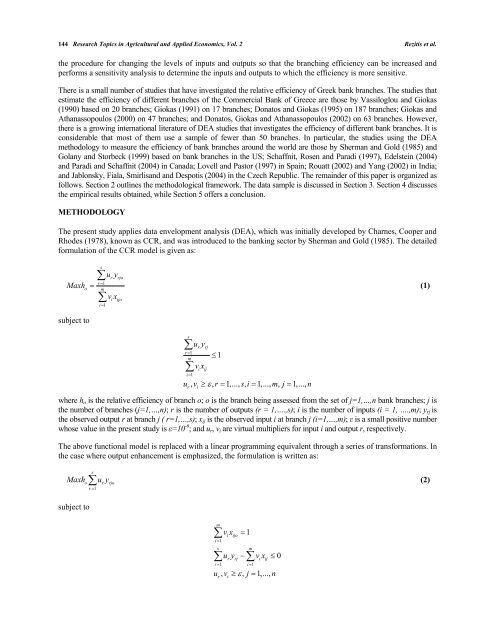chapter 2 - Bentham Science
chapter 2 - Bentham Science
chapter 2 - Bentham Science
You also want an ePaper? Increase the reach of your titles
YUMPU automatically turns print PDFs into web optimized ePapers that Google loves.
144 Research Topics in Agricultural and Applied Economics, Vol. 2 Rezitis et al.<br />
the procedure for changing the levels of inputs and outputs so that the branching efficiency can be increased and<br />
performs a sensitivity analysis to determine the inputs and outputs to which the efficiency is more sensitive.<br />
There is a small number of studies that have investigated the relative efficiency of Greek bank branches. The studies that<br />
estimate the efficiency of different branches of the Commercial Bank of Greece are those by Vassiloglou and Giokas<br />
(1990) based on 20 branches; Giokas (1991) on 17 branches; Donatos and Giokas (1995) on 187 branches; Giokas and<br />
Athanassopoulos (2000) on 47 branches; and Donatos, Giokas and Athanassopoulos (2002) on 63 branches. However,<br />
there is a growing international literature of DEA studies that investigates the efficiency of different bank branches. It is<br />
considerable that most of them use a sample of fewer than 50 branches. In particular, the studies using the DEA<br />
methodology to measure the efficiency of bank branches around the world are those by Sherman and Gold (1985) and<br />
Golany and Storbeck (1999) based on bank branches in the US; Schaffnit, Rosen and Paradi (1997), Edelstein (2004)<br />
and Paradi and Schaffnit (2004) in Canada; Lovell and Pastor (1997) in Spain; Rouatt (2002) and Yang (2002) in India;<br />
and Jablonsky, Fiala, Smirlisand and Despotis (2004) in the Czech Republic. The remainder of this paper is organized as<br />
follows. Section 2 outlines the methodological framework. The data sample is discussed in Section 3. Section 4 discusses<br />
the empirical results obtained, while Section 5 offers a conclusion.<br />
METHODOLOGY<br />
The present study applies data envelopment analysis (DEA), which was initially developed by Charnes, Cooper and<br />
Rhodes (1978), known as CCR, and was introduced to the banking sector by Sherman and Gold (1985). The detailed<br />
formulation of the CCR model is given as:<br />
Maxh<br />
subject to<br />
<br />
s<br />
<br />
r 1<br />
o m<br />
<br />
uy<br />
r rjo<br />
vx<br />
i ijo<br />
i1<br />
s<br />
<br />
r 1<br />
m<br />
<br />
i1<br />
r rj<br />
i ij<br />
1<br />
u , v , r 1,..., s, i 1,..., m, j 1,...,<br />
n<br />
r i<br />
uy<br />
vx<br />
where ho is the relative efficiency of branch o; o is the branch being assessed from the set of j=1,…,n bank branches; j is<br />
the number of branches (j=1,…,n); r is the number of outputs (r = 1,….,s); i is the number of inputs (i = 1, ….,m); yrj is<br />
the observed output r at branch j ( r=1,…,s); xij is the observed input i at branch j (i=1,…,m); ε is a small positive number<br />
whose value in the present study is ε=10 -6 ; and ur, vi are virtual multipliers for input i and output r, respectively.<br />
The above functional model is replaced with a linear programming equivalent through a series of transformations. In<br />
the case where output enhancement is emphasized, the formulation is written as:<br />
s<br />
Maxh u y<br />
(2)<br />
subject to<br />
o r rjo<br />
r 1<br />
m<br />
<br />
vx<br />
1<br />
i ijo<br />
i1<br />
s m<br />
<br />
uy vx 0<br />
r rj i ij<br />
r1 i1<br />
u , v , j 1,...,<br />
n<br />
r i<br />
(1)

















